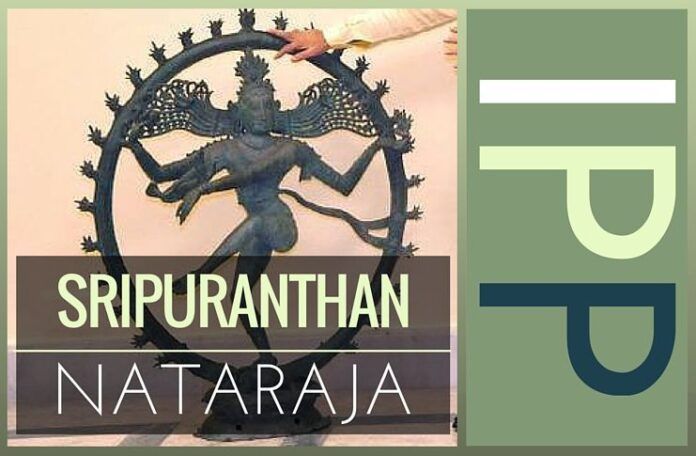
The case of Sripuranthan Nataraja
Of the many wonders that Cholas were famous for, their most outstanding creation were certainly ‘Chola bronzes’. These idols stood out for their beauty, intricate carvings and of course superior quality. No artisan before or after mastered the art of sculpting bronzes like the Chola artisans did. In fact, theirs artefacts were indeed ‘poetry in bronze’ and hence highly valued both then and now. No wonder several of the stolen and smuggled artefacts are Chola bronzes and today we will look into the case of one such highly valued bronze idol.
Nataraja is a manifestation of Shiva and one of the most popular forms worshipped particularly in Tamil Nadu. Nataraja literally translates to ‘King of dancers’ and as the name suggests this manifestation of Lord Shiva is a dancer. The Nataraja also happens to be one of the most popular and widely sculpted Chola bronzes. Next in line in our series based on http://poetryinstone.in/ cases is the mystery of one such Nataraja idol smuggled and shipped abroad.
Identifying the idol
The National Gallery of Australia (NGA) had on display among several other heritage objects a 900 year old idol of the Dancing Shiva that is Nataraja. Chasing Aphrodite (Chasing Aphrodite) dug into the details of how and when the idol came to be at NGA, what were the costs involved etc. Their investigation threw up evidences that proved the idol had been stolen from a temple in Tamil Nadu. In essence, the gallery had been displaying a stolen and smuggled heritage. While it is not the scope of this article to go into the details of the investigation conducted by the team at Chasing Aphrodite, we will take a look at how http://poetryinstone.in/ identified the place of origin of the said idol.
Cracking the case
There was now the task of identifying to which temple this stolen idol belonged. The idol was either from Sripuranthan or Suthamalli. It is believed that the idol closely resembles one of the two Natarajas and therefore the team then took up the task of studying photographic evidences to identify which one it resembled.
They did a comparative study of the Prabhavali or the ring of flames around the deity. The major roadblock was that all Nataraja statues look similar and there are a number of them that belong to South Indian temples. However, not all Nataraja statues are the same for an expert. Here’s what the blog has to say “To the trained eye it is very easy to spot the differences, credit again goes to the lost wax process wherein each is designed by hand, uniquely in wax before being cast in metal”. Another issue was that the photographs in their possession, obtained from the Idol wing/Archive wasn’t clear enough.
The team then did a thorough study of the circle of flames to look for evidences and identify the temple the NGA Nataraja belonged to. After carefully poring over the pictures, the team reached the conclusion that this was the Sripuranthan bronze. It was established that the idol was stolen from the Brihadeeswara temple at Sripuranthan and smuggled to Art of the Past owner Subash Kapoor. They also concluded that the idol had been removed from its pedestal.
Bringing the Lord back home
Following the investigation and arrest of Subash Kapoor in USA the idol was removed from display at NGA. The said idol was returned to the Indian Prime Minister in September 2014 along with the idol of Ardhanareshwar (another antique stolen and smuggled abroad which was in the possession of Art Gallery of New South Wales). Australian Prime Minister handed over these treasures to his Indian counterpart on 5th September.
The Lord has since been brought back to the country of origin. Although the idol was permitted to be taken on a procession through the town of Sripuranthan, the officials declared that the idol would be housed at the Government Museum at Kumbakonam and not at Sripuranthan Temple. However, the Lord will be brought to Sripuranthan during major festive occasions.
Opening the flood gates
However, the major victory in this entire case is not in the return of the Sripuranthan Nataraja. The greater victory lies in the arrest of Subash Kapoor and busting the antique stealing and smuggling racket of his ‘Art of the Past’ venture. His arrest put all his sales under the scanner and museums the world over started investigating their purchases. It opened the flood gates for the investigation and return of several antiques belonging to India. The latest case of ‘ghar wapsi’ (bringing the idols back home) is that of 200 stolen idols being returned to India by the US during PM Modi’s June 2016 visit. This will pave the way for many such antiques spread across the world to be brought back home. Finally IPP’s efforts seem to be bearing fruit.
Links for further reference:-
3) https://en.wikipedia.org/wiki/Sripuranthan_Natarajan_Idol#Subhash_Kapoor
- Revering our rivers: a story of revival - August 22, 2016
- The saga of the elephant headed God – Sripuranthan Ganesha - July 22, 2016
- Ghar Wapsi of Chola bronzes - June 20, 2016










